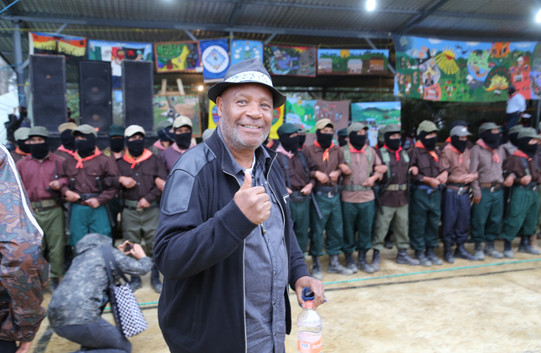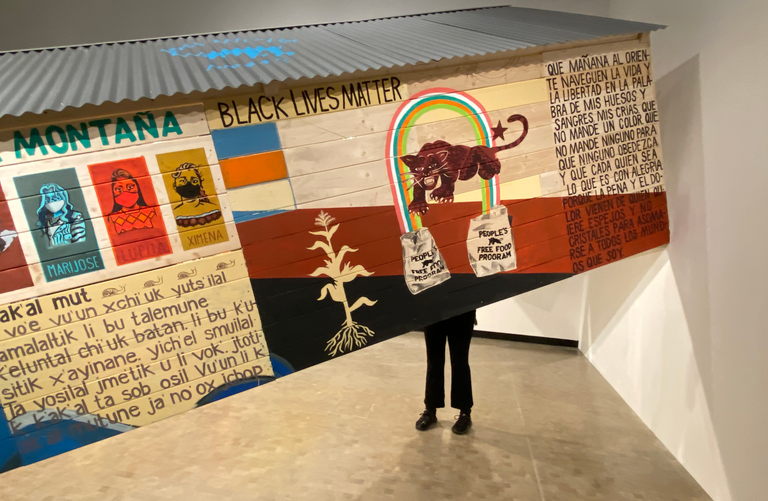


Zapantera Negra: An Artistic Encounter Between Black Panthers and Zapatistas
PROJECT OVERVIEW
In 1994 the Zapatista uprising, a Mexican indigenous movement from the southern state of Chiapas, produced and leveraged a different form of mass communication with the use of images, the body, and instant communication through the use of the Internet. The distribution of actions, images and video spread throughout the world in real time, bringing awareness while building solidarity for what the New York Times called “the first post-modern revolution.” Positioning itself as a struggle against neo-liberalism and waged against 500 years of oppression, Zapatismo has employed new technologies of information distribution in order to articulate their wants, beliefs, and various identities to their global audience.
EDELO (Where the United Nations Used to Be)
In the Fall of 2009, over one hundred displaced indigenous community members occupied the offices of the United Nations, located in San Cristóbal de las Casa, Chiapas, Mexico. The offices were taken over in the hope of gaining international attention from humanitarian organizations. After a few months of the occupation, the United Nations simply decided to find another building and moved.
A few months later, Mia Eva Rollow and Caleb Duarte, disillusioned with institutional art, wished to believe that art was a radical form of communication, and soon moved into the building and began an experimental art space and an international artist residency of diverse practice. They began to invite artists, activists, cultural workers, inventors, gardeners, PhDs, jugglers, and educators to take part in creating an experiment in art and social change. This group of artists, disenchanted by the continuing linear path of art history, came to EDELO (En Donde Era la ONU / Where the United Nations Used to BE) in favor of art as a vehicle for possible transformation.
Inspired by the 1994 indigenous Zapatista uprising, where word and poetry are used to inspire a generation to imagine ‘other’ possible worlds, EDELO has retained the name of the UN office. It is a part of an investigation into how Art, in all its disciplines and contradictions, can take the supposed role of such institutional bodies to create understanding, empathy, and to serve as a tool for imagining alternatives to a harmful and violent system that we do not have to accept.
Zapantera Negra gathered the visual results of four encounters, beginning in 2012 and ending in 2016, between the Black Panthers and Zapatistas and guided by the works and presence of Emory Douglas, former Minister of Culture of the Black Panther Party. For this encounter, Emory teamed up with Zapatista women embroidery collectives, Zapatista farmers and painters, and with local artists, activists and musicians to create new works that reflect and celebrate these two powerful movements. Each movement presents a distinct position in terms of cultural and political milieus, yet both build from a shared understanding of the power of art. From public interventions, installations, video art, performance, mural painting, lectures, and living and working with Zapatista families, Zapantera Negra presents a collection of works ignited collectively by the public’s urge and necessity to demonstrate, protest, and create. And in times of much revolutionary fever and economic inequality, we feel it is important to share what art can and has done to create change.
Such a radical break is presented by the creation of the Black Panther Party for Self-Defense in 1966 and the artworks created by Emory Douglas for its newspaper. At its peak in 1970, 400,000 copies of The Black Panther newsletter were distributed weekly throughout the United States on a weekly basis. Within its pages, Emory Douglas, published his artworks in an effort to “illustrate conditions that made revolution seem necessary [and to] construct a visual mythology of power for people who felt powerless and victimized.” The newsletter and its accompanying illustrations played a central role in the articulation of the “What We Want, What We Believe” portion of the Black Panther’s Ten Point Program. The BPP newspaper helped to establish a Black Panther aesthetic of Black Power and Revolution.
Although the Black Panther and the Zapatista movements occurred in distinct cultural, political, and historical milieu, the two share a common appreciation of the power of the image and the written word to translate their respective social movements into personal, collective, transformative, and public experiences. In contrast to the strong self-definition established and disseminated by these two movements via pertinent media channels, today’s multimedia, plugged-in landscape seems to promote the opposite process. As opposed to contemporary ‘high art’ practices taught by leading institutions, Zapantera Negra is a project that demonstrates how contemporary art practices can sidestep conventional political and conceptual performative works by working in communities of struggle from the ground up. This is a grassroots effort to bring together two very powerful visual and political social movements.
FULL VIDEOS AND PHOTO DOCUMENTATION OF ALL ENCOUNTERS AND EXHIBITIONS COMING SOON. WEB PAGE IN TRANSITION.



La Flor De La Palabra. Fresno State University. 2016



La Flor De La Palabra. Fresno State University. 2016
COMPARTE Festival 2016, Oventic y la Universidad de la Tierra.










